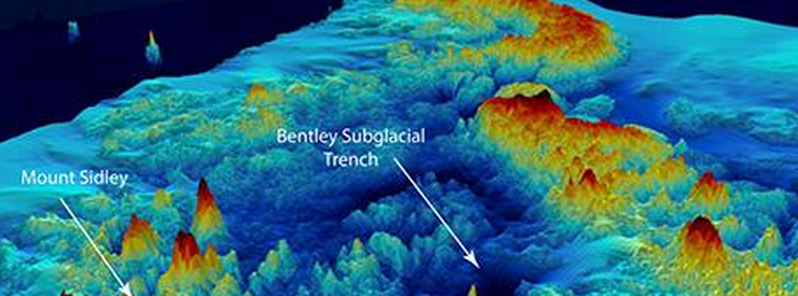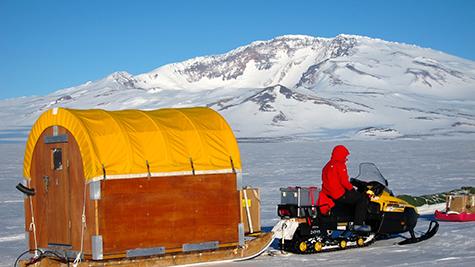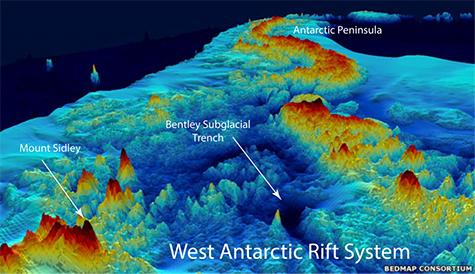Seismic maps of the Earth’s mantle beneath Antarctica provide first glimpse into underlying geology

A series of robust seismometers have been deployed in Antarctica to map the geology hidden underneath the vast ice sheets. For the first time, they have been successful in recording reverberations of distant earthquakes in the period between January 2010 and 2012 and used to create maps of seismic velocities beneath the rift valley in Antarctica. The conducted research has provided the scientists with the first glance at the Earth underneath the frozen, difficult to reach, regions.
The scientists have conducted a research to discover the underlying cause of the line of volcanoes emerging from the ice sheet in Antarctica. The series of measurements will hopefully also provide insight into how this is significant for the future of ice, the University of Washington in St. Louis reported on December 7, 2015.
The contrast between the surface and the depth of our planet is highly enhanced in Antarctica, more than anywhere else on the globe. Because the vast lands of the area are covered with extensive ice sheets, the scientist are unable to see the underlying geology directly and have to use geophysical measurements instead.

Lloyd on his Skidoo towing a Conestoga (the cook shack for the traverse team) in front of Mount Sidley, a volcano that blew out its side much as Mount St. Helens did. Image credit: Mike Roberts
"Our understanding of what’s going on is really hampered because we can’t see the geology. We have to turn to geophysical methods, such as seismology, to learn more,"said Andrew Lloyd, a graduate student in earth and planetary sciences in Arts & Sciences at Washington University in St. Louis.
To conduct measurements researchers have deployed seismometers across the West Antarctic Rift System and Marie Byrd Land during the austral summer of 2009/10. Andrew Lloyd returned in 2011 and snowmobiled over 1 600 km (1 000 miles), living in a Scott tent, to recover the data. This step marked the first time ever that seismologists have been able to deploy instruments robust enough to get through the frozen Antarctica winter.

The topography of West Antarctica below the ice sheet as viewed from above, looking toward the Antarctic Peninsula. Much of West Antarctica is a basin that lies below sea level (blue), although it is currently filled with ice, not water. West Antarctica was stretched and thinned as it moved away from East Antarctica, forming one of the world's largest continental rift systems. Image credit: Bedrock Consortium
The instruments recorded the reverberations of distant earthquakes in the period between January 2010 and January 2012 which have then been used to create maps of seismic velocities beneath the rift valley and provided a first detailed look at the Earth beneath Antarctica.
An expected giant blob of superheated rock about 96.6 km (60 miles) beneath Mount Sidley volcanic mountains chain in Marie Byrd Land was found at one end of the transect, while a surprisingly hot rock was discovered at the other end, beneath the Bentley Subglacial Trench deep basin. The discovery of a hot rock underneath the area suggest the recent activity of this part of the rift system.
Mount Sidley is the highest volcano in Antarctica and the southernmost mountain of the volcanic mountain range in Marie Byrd Land, situated just above a hot region in the mantle.
"A line of volcanoes hints there might be a hidden mantle plume, like a blowtorch, beneath the plate. The volcanoes would pop up in a row as the plate moved over it," explained Dr. Doug Wiens, professor of Earth and Planetary Sciences.
"But it’s a bit unclear if this is happening here. We think we know which direction the plate is moving, but the volcanic chain is going in a different direction and two additional nearby volcanic chains are oriented in yet other directions. If this was just a plate moving over a couple of mantle plumes, you’d expect them to line up, as they do in the Hawaiian Islands,"he added.
The discovery of a hot zone underneath the Bentley Subglacial Trench was the most interesting discovery of the study.The Bentley basin is a part of the West Antarctic Rift System, a series of rifts, adjacent to the Transantarctic Mountains, along which the continent was stretched and thinned.
"If you removed the ice, West Antarctica would rebound, and most of it would be near sea level. But the narrower and deeper basins might remain below it. The Bentley Subglacial Trench, which is the lowest point on Earth not covered by an ocean, would still be a kilometer and a half below sea level if the ice were removed,"Lloyd said.
The West Anatarctic Rift is hidden, which is why much less is known about than about other well-known rift systems, such as the East African Rift or the Rio Grande Rift. The rift valley was created about 100 million years ago, during a period of diffuse extension. The following focus extension, which likely occurred in the Neogene, created the Bentley Subglacial Basin and the Terror Rift in the Ross Sea.
"We didn’t know what we’d find beneath the basin. For all we knew it would be old and cold. We didn’t detect any earthquakes, so we don’t think the rift is currently active, but the heat suggests rifting stopped quite recently," Wiens said.
The rift system most likely poses a high influence on ice streams in West Antarctica. Because rifting and ice flow occur on different time scales, it won't suddenly render the ice sheet unstable. In order to model how quickly the ice is going to flow, or the rock will rebound, it is necessary to have a thorough understanding of the boundary conditions, such as heat flow from the mantle, for the model.
"Seismic surveys like this one will help inform models of the ice sheet. Modelers need an estimate of the heat flow, and they need to know something about the geological conditions at the bottom of the ice sheet in order to estimate drag. Right now, both of these factors are very poorly constrained," Wiens explained.
The heat flow through the Earth's crust has only been measured at a few places in Antarctica so far. The scientists observed the flow at one of the places to be four times higher than the global average in July 2015. According to Wiens, the recent extension in the Bentley Subglacial Trench could explain these readings.
The next challenge for the scientists will be to understand the structure under the Thwaites and Pine Island glaciers, referred to as the "weak underbelly" of the ice sheet. Surges in the ice flow at these places could cause the rapid disintegration of the entire West Antarctic ice sheet.
A network of additional 10 seismic stations was deployed during the 2014/15 Antarctic field season, which will work with the earlier deployed array of seismometers to map the underside of this important region.
Reference:
- "A seismic transect across West Antarctica: Evidence for mantle thermal anomalies beneath the Bentley Subglacial Trench and the Marie Byrd Land Dome" Andrew J. Lloyd, Douglas A. Wiens Andrew A. Nyblade, Sridhar Anandakrishnan, Richard C. Aster, Audrey D. Huerta, Terry J. Wilson, Ian W.D. Dalziel, Patrick J. Shore, Dapeng Zhao – Journal of Geophysical Research Solid Earth (2015) – DOI: 10.1002/2015JB012455
Featured image: The topography of West Antarctica below the ice sheet as viewed from above, looking toward the Antarctic Peninsula. Much of West Antarctica is a basin that lies below sea level (blue), although it is currently filled with ice, not water. West Antarctica was stretched and thinned as it moved away from East Antarctica, forming one of the world's largest continental rift systems. Image credit: Bedrock Consortium

Commenting rules and guidelines
We value the thoughts and opinions of our readers and welcome healthy discussions on our website. In order to maintain a respectful and positive community, we ask that all commenters follow these rules:
We reserve the right to remove any comments that violate these rules. By commenting on our website, you agree to abide by these guidelines. Thank you for helping to create a positive and welcoming environment for all.